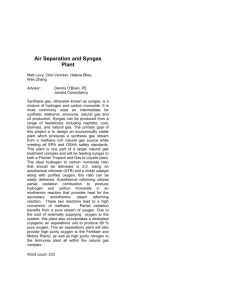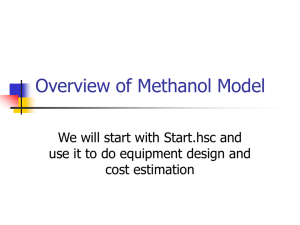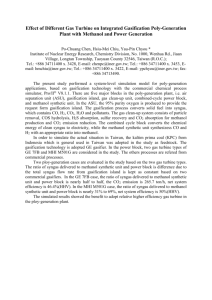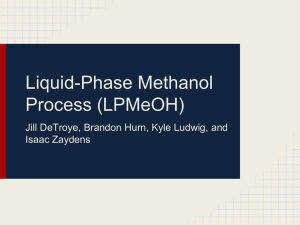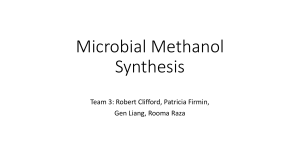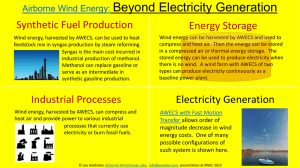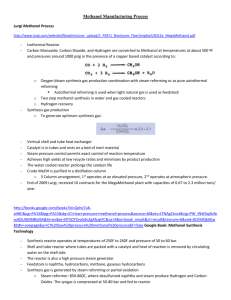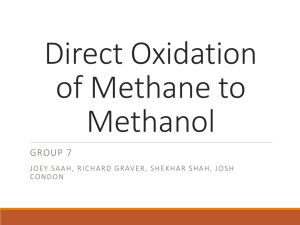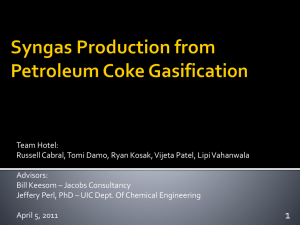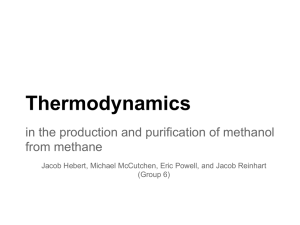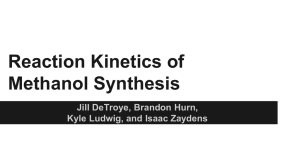Literature Survey of Two-Step Methane-syngas
advertisement
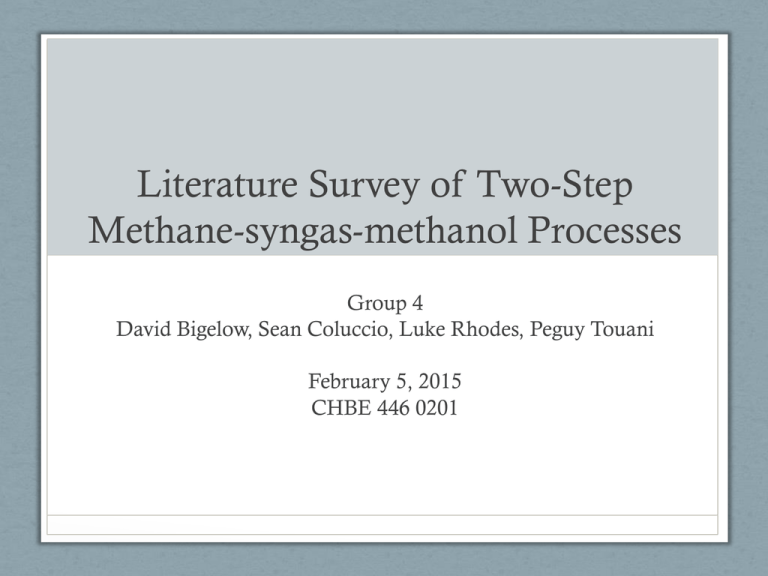
Literature Survey of Two-Step Methane-syngas-methanol Processes Group 4 David Bigelow, Sean Coluccio, Luke Rhodes, Peguy Touani February 5, 2015 CHBE 446 0201 Background CH4 + H2O → 3 H2 + CO CO + 2 H2 → CH3OH • The production of synthesis gas from methane produces three moles of hydrogen gas for every mole of carbon monoxide, while the methanol synthesis consumes only two moles of hydrogen gas per mole of carbon monoxide. Background cont. • To deal with the excess hydrogen, CO2 is injected in the methanol reactor where it forms methanol and water CO2 + 3 H2 → CH3OH + H2O Reactors and Catalysts • There are two types of reactors used today: adiabatic and isothermal • Carbon monoxide and hydrogen react over a catalyst to produce methanol • Catalyst: 1. Zn/Cr2O3 at high pressure and temperature with impure syngas 2. Cu/Zn/Al2O3 are widely use today and is used at lower conditions Step 1: Conversion of Methane to Syngas • Preparation of Synthetic gas typically accounts for 5075% of the total capital cost of a Gas-to-Liquid (GTL) plant • Steam Reformation (SR) has been used for decades and forms a hydrogen rich syngas • Catalytic Partial Oxidation (CPOX) is a newer technology that oxidizes methane to form syngas Catalytic Partial Oxidation Steam Reformation • • • Methane is contacted with steam over a heated catalyst at high pressures and temperatures to produce a high hydrogen content syngas Requires large heat exchangers and a large initial investment Strict heat balance requirements which makes it hard to control and difficult to scale down to a small size • Methane is reacted with oxygen over a catalyst bed to yield syngas at a 2:1 hydrogen ratio • Operated at moderate pressures (0.5 - 4 MPa) which is compatible with downstream processes • Easier to control and manipulate reactor sizing • Newer technology that lacks research in comparison to steam reformation Step 2: Methanol Synthesis from Syngas • CO + 2H2 ↔ CH3OH • The original methanol synthesis process was operated at high temperature and pressure • Methanol is now generally synthesized using a slightly different reaction, which has the addition of CO2 as a reactant • Modern plants will also use the heat produced from the methanol synthesis for the steam reformation reaction Reactors • Two main types of reactors are used today, adiabatic and isothermal • Adiabatic reactors generally use injection of cooled syngas, whether it is fresh or recycled • Isothermal reactors are continuously cooled, though generally from another source, and operate similarly to heat exchangers • Both types of conventional reactors utilize fixed bed catalysts • The Liquid Phase Methanol Synthesis process is used less often and utilizes slurry reactors instead of conventional fixed bed reactors Reactor Examples Linde Isothermal Reactor Lurgi Methanol Converter (Isothermal) http://www.zeogas.com/files/8393 9793.pdf http://www.lindeindia.com/userfiles/image/File/Linde%20 Isothermal%20Reactor.pdf Reactor Examples Cont. Topsoe Collect, Mix, Distribute Converter (Adiabatic) http://www.topsoe.com/sites/default/files/topsoe_methanol_coal_ba sed_plants.ashx_.pdf Reactor Examples Cont. Slurry Reactor http://www.gasification.org/uploads/eventLibrary/gtc9807p.pdf Catalysts • The first catalyst used was Zn/Cr2O3 at high pressure and temperature with impure syngas • In 1966 a Cu/Zn/Al2O3 catalyst began seeing use, and allowed operation at much lower conditions • This Cu/Zn/Al2O3 catalyst is still used today, and remains the popular choice for methanol synthesis Conclusion • Two step process of: 1. Conversion Methane to Syngas 2. Methanol Synthesis from Syngas • Varying forms of operation • Most reactors use similar, using small range of catalysts • Preferable for medium to large scale processes References • M. Lyubovsky, S. Roychoudhury, R. LaPierre. “Catalytic partial oxidation of methane to syngas at elevated pressures. Catalysis Letters. Vol. 99, Nos. 3-4, February 2005. • http://bioweb.sungrant.org/Technical/Bioproducts/Bioproducts+from+Syngas/ Methanol/Default.htm • http://www.syngaschem.com/syngaschem
